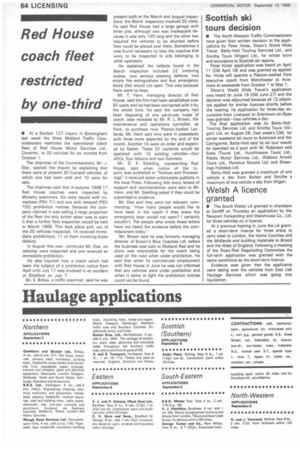Red House coach fleet restricted by one-third
Page 66

If you've noticed an error in this article please click here to report it so we can fix it.
• At a Section 127 inquiry in Birmingham last week the West Midland Traffic Commissioners restricted the operational coach fleet of Red House Motor Services Ltd., Coventry, to 20 vehicles for six months from October 1.
The chairman of the Commissioners, Mr. J. Else, opened the inquiry by explaining that there were at present 30 licensed vehicles, of which one had been sold and 10 were for sale.
The chairman said that in autumn 1968 17 Red House coaches were inspected by Ministry examiners. Six were issued with immediate (PSV 71/ and one with delayed (PSV 102} prohibition notices. Because the company claimed it was selling a large proportion of the fleet the only action taken was to warn it that a further fleet inspection would be held in March 1969. This took place and, out of the 20 vehicles inspected, 14 received immediate prohibitions, 11 of them involving brake defects.
In August this year, continued Mr. Else, six vehicles were inspected and one received an immediate prohibition.
He also inquired how a coach which had been the subject of a prohibition notice from April until July 17 was involved in an accident at ,Stratford on July 7.
Mr. E. Bilbey, a traffic examiner, said he was present both at the March and August inspections; the March inspection involved 20 visits.
He said Red House had a large garage with three pits, although one was inadequate because it was only 15ht long and the other two required the vehicles to be shunted before they could be placed over them, Sometimes it was found necessary to take the coaches that were to be inspected to pits belonging to other operators.
He explained the defects found in the March inspection included 22 involving brakes, two serious steering defects, two empty fire extinguishers and four emergency doors that would not open. This was because there were no keys, Mr. T. Venn, managing director of Red House, said the firm had been established over 50 years and he had been connected with it for the whole time. He said the company had been disposing of one particular make of coach, later revealed by Mr. R. L. Brown, the maintenance and operations controller, as Ford, to purchase new Plaxton-bodied Ley lands. Mr. Venn said nine were in possession with three more expected by the end of the month. Another 10 were on order and expect ed by Easter. These 22 Leylands would be operated with 10 existing vehicles—four AECs, four Albions and two Daimlers.
Mr. D. E. Skelding, representing Red House, said when notice of the in
quiry was published in -Notices and Proceedingsit received some unfortunate publicity in
the local Press. Following this many letters of support and commendation were sent to Mr. Venn, and Mr. Skelding asked if they could be submitted in evidence.
Mr. Else said they were not relevant, commenting: ''How many people would like to have been in the coach if they knew the emergency door would not open? I certainly wouldn't. The people who wrote those letters have not heard the evidence before the commissioners today."
Mr. Brown said he was formerly managing director of Brown's Blue Coaches Ltd. before the business was sold to Midland Red and he alone was responsible for the coach being used on the road when under prohibition. He said that when he commenced employment with Red House in June he was not informed that any vehicles were under prohibition and when it came to light the prohibition notices could not be found.




































































































































































































